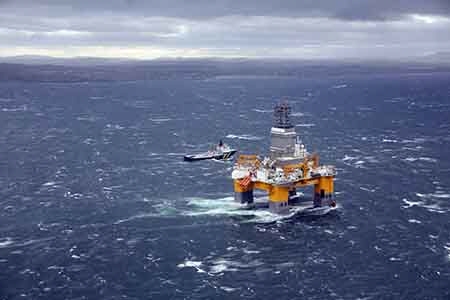
The box chart below shows the average drilling difficulty (on a P50 basis) of offshore wells drilled in the North Sea basin from 2000 to 2016. The data suggests that the average drilling difficulty hasn’t changed very much over the last two decades – it has been relatively flat. The Rushmore Drilling Index (RDI) is a measure of the difficulty of drilling a well and is used for normalisation purposes. The numbers in parenthesis represent the number of wells that were drilled to Total Depth in a given year.
Having said that, it is the following chart (below) that is even more curious, perhaps visually illustrating a recurring trend we’ve seen time and again, a prevailing culture in the upstream sector of the oil & gas industry. The chart looks specifically at the North Sea, and suggests that as the average oil price increased, the average drilling performance was relatively flat or got worse. It also reveals that as the average oil price decreased the average drilling performance improved. This troubling trend seems to suggest that the industry has a proclivity for paying attention to drilling performance, or more broadly, efficiency, and actively does something about it only when oil prices start sliding towards a downturn…
Since mid-2014, when oil prices started to plummet, oil companies have sought and worked assiduously to bring down gross unit costs through various means. One of the key cost reduction drivers, and arguably one of the most sustainable, has been a commitment to pay more close attention to operational efficiencies with a view of improving performance where possible. For example we have since seen the average drilling performance of offshore wells in the UK between 2015 & 2016 improve by ~40% (on a P50 basis).
Given that 60% of field development costs come from well construction, a 40% improvement in drilling performance would have seen a significant reduction in wells costs. The metric used for drilling performance in this article, “Metres / dry hole day ex. core & log” is the rate of penetration during drilling operations excluding data acquisition – coring & logging days. This makes exploration, appraisal & development wells directly comparable (exploration & appraisal wells can have extensive logging programmes compared to development wells), and more importantly gives you a convenient measure of drilling performance since it focuses solely on the rate of hole making without mixing this with other well objectives.
The theme for Offshore Europe this year, “Embracing New Realities: Reinventing our Industry” is a very apt topic for this season in the industry, and I should like to see the lessons learned from this downturn plus the wealth of knowledge that will be gained at the conference persist through any other downturn in the foreseeable future. As we go through a cultural shift in this cycle, the culture where being progressively efficient, only brought to the fore during challenging times will hopefully be laid to rest once and for all.
Wonuola Scott is the data transformation principal at IHS Markit and an executive committee member of Offshore Europe.
Recommended for you
